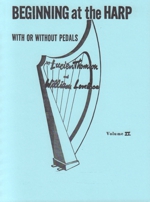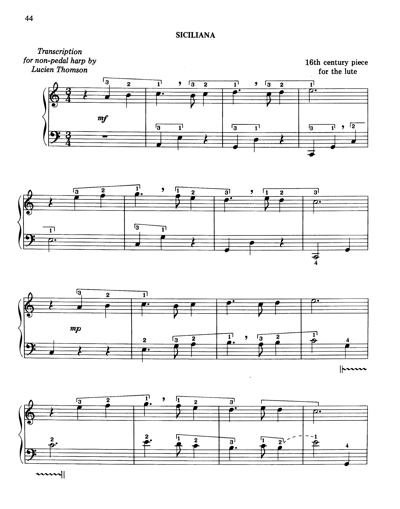 |
Beginning at the Harp Volume 2 Lucien Thomson & William Lovelace |
|
| Instrumentation: | Pedal or Lever Harp | |
| Level: | Beginner | |
| Format: | USA Letter plastic ring binding | |
| ISMN: | -- | |
| Publisher: | William Lovelace | |
| Edition/Year: | 1987 (assigned 2000) | |
| Origin: | USA | |
| Our Ref: | UM1315 | |
Buy this music now £22.00 +p&p |
||
| Other music by Lucien Thomson | ||
FOREWORD
The theory presented in this Book II is, of necessity, merely the barest outline for the Teacher to follow. It is imperative that much additional drill be given, both as assigned written work to be done at home, and as ear training and dictation at every lesson.
If the teacher has a piano in the studio, the problem is simplified in that the pupil can see the intervals. However, a piano is in no way necessary. Theory can be taught on the harp IF the ear training has been constant and thorough. If a solid foundation in ear training was developed while using BEGINNING AT THE HARP Bk. I, BEGINNING AT THE HARP Bk. II should hold no problems.
Teaching key signatures has been omitted. There are many published theory papers teaching the Circle of 5ths. It is thought that every teacher has already introduced the pupil to "why we have sharps and flats."
In many instances dynamics have been purposely omitted. The teacher and pupil must decide on the dynamics by singing and clapping the tune.
The authors felt that intervals, triads, and rhythm need more emphasis at this time. Therefore, the primary aim of the theory presented in this book is to stress the importance of the ability to HEAR major, minor, and perfect intervals as harmonic intervals; and to present triads and their inversions. After all, 1 - 3- 5- 8- 3 contains all of the intervals except 2nds and 7ths.
The majority of pieces and theory exercises in this book have been designed to accommodate the non-pedal harp tuned in the key of F. Exceptions have been noted in the text. Non-pedal accidentals (lever changes) are noted between the staves. Pedal harp accidentals are noted below the bass staff. The rhythm exercises aim to develop a feeling of rhythm through walking, clapping, and COUNTING OUT LOUD.
Effective teaching is conscientious, diagnostic, and repetitive; and the most difficult thing for a teacher to put across is how to practice. For, practice, too, must be conscientious, diagnostic, and repetitive. In Book II, the authors present PRACTICING WITH BOTH HANDS TOGETHER as the fundamental practice technique. Examples of how to practice with both hands accompany many pieces. It is senseless — and a great waste of time — to play each hand separately. The left hand should be trained to play anything that is required of the right hand.
The theory herein will aid in preparing a student, of any age, for the first theory test given during the Auditions and Evaluations organized by the Music Education Program of the American Harp Society, Inc.
